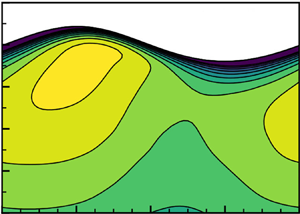Published online by Cambridge University Press: 07 October 2020

The dynamics of Reynolds stresses and turbulent kinetic energy (TKE) in Langmuir turbulence are analysed using data of large-eddy simulations with the wave phase resolved. It is found that the streamwise and spanwise Reynolds normal stresses and the Reynolds shear stress vary appreciably with the wave phase, while the vertical normal stress is only weakly dependent on the wave phase. Budget analyses indicate that the production due to wave straining and the effects associated with turbulence pressure are the dominant mechanisms for the wave-phase variation of Reynolds stresses. The accumulative effect of wave–turbulence interactions on TKE is then investigated using the Lagrangian average. It is discovered that the energy transfer from wave to turbulence is contributed by two mechanisms. The first mechanism is the turbulence production by the Lagrangian mean wave shearing and the mean shear stress, which is consistent with the traditional wave-phase-averaged model. The second mechanism, which is not accounted for in previous studies, is the correlation between the wave-phase variation of the Reynolds shear stress and the wave orbital shearing. A model is proposed for the second mechanism. Comparison of the frequency spectrum with Craik–Leibovich simulation results shows that the correlation effect can affect the turbulence fluctuations at time scales around the wave period, indicating the importance of this effect on Reynolds stresses and TKE.